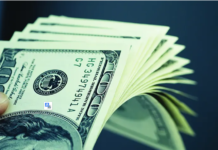
Bangladesh is taking on increasingly higher levels of debt to fund its infrastructure spending, crucial for the economy to level up to a middle-income one by 2041.
After the Awami League government came to power in 2009, it took up several monumental development projects with the view to transforming the country’s communication, transport and power infrastructure.
Eight mega projects are in implementation, whose completion is expected to raise Bangladesh’s GDP by as much as 4 percent.
Every year, thousands of crores are being diverted to them, along with the other infrastructural projects, which is raising Bangladesh’s debt level in the face of stubbornly low revenue growth.
At the end of last fiscal year, Bangladesh’s total debt to GDP ratio hit a 13-year-high of 38 percent — way below the 70 percent threshold recommended by the International Monetary Fund, according to a recent report of the finance ministry.
As of June 30, the total outstanding debt stood at Tk 11,44,297 crore, 36.7 percent of which is attributed to foreign sources.
At the end of last fiscal year, Bangladesh’s total external debt stood at Tk 420,358 crore, which is the lowest in the last six years. It is equivalent to 13 percent of GDP, meaning comfortably below the IMF’s recommended threshold of 55 percent.
“At the current level, Bangladesh’s total debt is sustainable,” said Zahid Hussain, a former lead economist of the World Bank’s Dhaka office.
In other words, the country is at low risk of debt distress even if the current growth and financing conditions change in unfavourable ways but within foreseeable bounds.
“There is a significant cushion between what is considered a sustainable threshold and the current debt to GDP ratio.”
The effective nominal interest rate on the total debt is about 6 percent, which compares favourably with the nominal GDP growth of more than 10 percent, Hussain said, adding that the effective real interest rate is below 1 percent.
“We will not overborrow,” said Finance Minister AHM Mustafa Kamal, adding that the government has a set maxim for borrowing.
The government would not borrow huge amounts of money when it is still a developing country.
“We have decided not to borrow heavily and will always keep borrowing in line with the GDP.”
He went on to state that Bangladesh never failed to repay its loans.
“We always do the debt servicing timely. That is why the development partners have faith in us,” Kamal added.
Hussain said there is room for improving public debt management.
“There is the room because the opportunities for concessional debt financing, while waning, are not exhausted. This means we can reform the composition of debt to make it even less costly.”
There is a need for such reforms because interest expenditure constitutes 2.3 percent of GDP, which is higher than the expenditure on education relative to GDP and about one-fifth of total tax revenues, Hussain said.
Out of the domestic debt, 48 percent is thanks to the national savings certificate, for which the interest rate varies from 10 to 11 percent.
In contrast, banking sources, whose interest rate ranges from 2 to 8 percent, account for 46 percent of the domestic debt.
For borrowing from foreign sources, the interest is still less than 2 percent with a repayment period of 20 to 30 years.
“There is an opportunity to build more fiscal space under the prevailing financing conditions. The latter cannot be taken for granted in a world vulnerable to disruptive changes,” Hussain added.
Kamal hinted that the interest rate on foreign loans would not increase in future even if the country graduates from the least-developed country bracket in 2026.
The government is negotiating with the development partners so that it could borrow at low-interest rates for a long period with the view to making the graduation to the developing country bracket sustainable following the global coronavirus pandemic, he said.
In fiscal 2021-22, the government has allocated Tk 68,589 crore for loan repayment. In fiscal 2009-10, the amount was Tk 14,646 crore.
The amount of total foreign debt servicing also rose to $1,900 million in fiscal 2020-21, which was at $876 million in fiscal 2009-10.
There is also room for improving the return from debt-financed expenditures by improving the efficiency of public investment management, Hussain said.
Public investment projects take too long to complete and often exceed the budget by a multiple of the original budget, he added.
A total of 10 megaprojects, which would have a substantial impact on the economy and wellbeing of the population, were singled out for fast-tracking.
And yet, the projects, for which thousands of crores were diverted over the past decade, are behind on their schedule.


 For all latest news, follow The Daily Star’s Google News channel.
For all latest news, follow The Daily Star’s Google News channel. 







